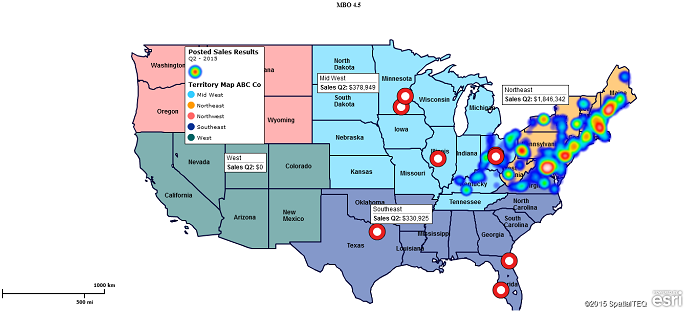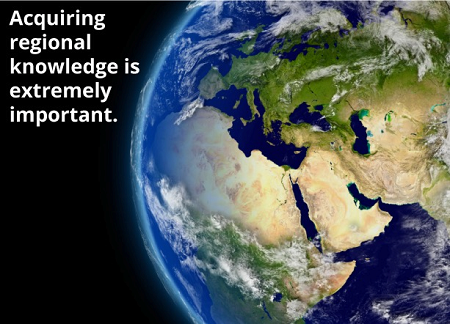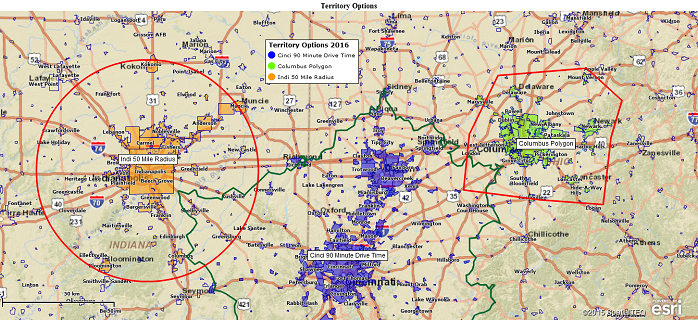How to Set Up Sales Territories

What is the one step you can take today to boost sales, increase efficiency and position your company as a respected industry leader? Here’s a hint: The answer is the same whether you’re the CEO of a small startup or a sales leader in a multinational conglomerate. Here’s another hint: It comes down to effectively defining your prospective buyers.
If you said “develop sales territories”, you nailed it. There is, quite simply, no single other action as powerfully transformative for any business concerned with sales. In fact, we feel so strongly about sales territory planning that we’ve prepared an introductory primer for your business. Read on to learn about the importance of balanced sales territories, different ways for planning sales territories and effective tools you can use when creating sales territories.
What Are Sales Territories?
 Sales territories are clusters of potential clients, to which a team of sales representatives is assigned. These clusters can be geographic in nature, based on historical sales trends or certain client demographic factors — or a combination of these.
Sales territories are clusters of potential clients, to which a team of sales representatives is assigned. These clusters can be geographic in nature, based on historical sales trends or certain client demographic factors — or a combination of these.
Sales territories provide a simple organizational structure to help you allocate resources and track results effectively. Done well, they will reduce expenditures, increase sales and streamline your operations. But done poorly, they’ll impair you at every turn until finally reformulated. That’s why it’s important to get it right the first time.
Sales territories are a well-known concept to most sales leaders. Even so, many fail to recognize the true value of effective sales territory - management and understand how to best develop their own territories. After all, each business is unique, and there is hardly a standard set of boundary line rules that fit every company equally. It has never been more important for would-be industry frontrunners to get a basic handle on setting up sales territories. Take a moment with us to learn about planning sales territories, including both the “why” and the “how”.
The Importance of Balanced Sales Territories
First thing’s first: Why do you need to define sales territories at all? What is preventing your company from leaving sales as more of a free-for-all, focusing attention and resources elsewhere? The answer is nothing, technically. But there is no shortage of reasons why this would be a bad move.
First and foremost, sales territories provide direction and a basic organizational framework to your sales force. They encourage the formation of efficient standing travel routes across the region, provide (in conjunction with team managers) each sales rep with a clearly defined periodic task and ensure every client of interest is properly attended to. Without this sort of guidance, your sales reps could easily fall into sales chaos where certain objectives are lost and coverage areas overlap creating sales redundancy — not out of malevolence, but merely confusion. It’s a big world out there, with a lot of calls to be made.
Management, too, becomes a far easier task with dedicated teams focusing on distinct territories. Sales leaders heading small teams can become intimately familiar with the strengths and habits of each representative, making it a breeze to assign the ideal rep to each client and stay apprised of every action he or she takes.
Another key benefit is that sales territories can help you discover new opportunities before your competitors do. While an unorganized sales force may be aimless and inefficient at finding unexplored angles, a properly aligned collection of territories inspires focused exploration within a manageably sized region. Consider how much harder a territory focused sales rep is going to work at replacing a fading industry? As the paper industry declines, tanking their quota, they beat the bushes and discover the biotech industry is up and coming and in need of your products.
 Your end goal in creating sales territories should be balance — balance between the geographical size of the area, between the number of prospects in each territory and between any other relevant criteria for your business. Failure to do so means frequent restructuring and remapping. But by regularly considering geographic balance in your territory analysis, your business will grow into a mature sales organization that analyzes territory results and can adjust to accommodate real challenges in the marketplace or in your sales force.
Your end goal in creating sales territories should be balance — balance between the geographical size of the area, between the number of prospects in each territory and between any other relevant criteria for your business. Failure to do so means frequent restructuring and remapping. But by regularly considering geographic balance in your territory analysis, your business will grow into a mature sales organization that analyzes territory results and can adjust to accommodate real challenges in the marketplace or in your sales force.
The impact of no geographic assignment goes beyond a few extra meetings for management. Your sales reps, who are suddenly no longer able to capitalize on personal familiarity with their customers or the nuances of acquired knowledge of their previously assigned region, will be left impaired with every new shuffle of the map. The result can be lost productivity, less-satisfied clients and lowered employee morale.
Successfully creating balanced sales territories is an orderly process that becomes scenic nature over time for you planners. It’s a process that draws upon carefully gathered data about your target marketplace. The next question to consider: What data, exactly, is most relevant to you? This is where the importance of choosing the right metrics becomes apparent.
Sales Territory Planning: Choosing Metrics and Collecting Data
How can you establish sales territories that will improve long term sales results? As with any good system, you’ll need to start by selecting the metrics that most effectively align each zone. There will be plenty of factors that differentiate your accounts, but the goal here is to determine the ones that are the most beneficial to sales growth.

Think about what you ultimately want to accomplish. It’s helpful to treat the question like a pen-and-paper maze: Start from the end and work backwards. What is your total target sales revenue? Now you need to identify the buyers who are most likely to allow you to reach that goal. Once you have a profile of the buyer, how can you sell to him or her?
All of this is vital information for any sales team, but it’s the latter questions that really inform your sales territory strategy. Once you know who your clients are and how to reach out to them effectively, grouping them by location within territory boundary lines becomes that much easier.
Let’s take a look at some of the most common metrics utilized by sales leaders today:
 Geography
Geography
Incorporating geography to break down sales territories has several substantial benefits. In addition to being very straightforward to implement, geography’s cut-and-dry nature discourages infighting about who is (or should be) responsible for which areas. There’s little for managers with adjacent zones to dispute in a binary system like this: Territory X is either in Region Y, or it isn’t.
Furthermore, for sales teams that must travel in between clients for face-to-face meetings and pitches, having one continuous territory region — rather than bits and pieces scattered around the country/world — limits the amount of travel required. Life on the road isn’t great for employee morale. After all, time spent with clients is productive, and time behind the wheel is not.
 Finally, don’t underestimate the importance of acquired regional knowledge, especially for a business that operates internationally. You cannot simply assign cases to salespeople unfamiliar with the culture of their clients and expect quality results. Think about rural Quebec, an area close to the Northeast US. Did you know that that area is strictly French speaking? Make sure a sales person for that area speaks fluent French.
Finally, don’t underestimate the importance of acquired regional knowledge, especially for a business that operates internationally. You cannot simply assign cases to salespeople unfamiliar with the culture of their clients and expect quality results. Think about rural Quebec, an area close to the Northeast US. Did you know that that area is strictly French speaking? Make sure a sales person for that area speaks fluent French.
We’ve previously gone over some of the reasons why it’s best to stick with counties, states or ZIP codes when defining geography-based sales territories. In short, using these pre-existing administrative boundaries removes the extra work of drawing up arbitrary new boundaries, and it demands greater accountability from the average salesperson (no neglecting fuzzy “gray areas” around the border). These common geographic districts have easy to access demographic information available, published by the US Census Bureau. This data will naturally enhance your market analysis over the exact same territory boundaries that your sales territories are based on.
 Anticipated Return on Investment
Anticipated Return on Investment
One tactic taken by many of the pros is to (internally) rank clients on the amount of revenue they are expected to generate vs. the amount of time or other resources it will likely take to gain that revenue. Using this ratio, you can form several categories. For instance, one for high-return, reliable clients; one for potential gold mines who will take some effort to reach; and one for clients who demand plenty of sales effort for limited return.
Using these ranked groups, sales leaders can best communicate to teams the tactics they will be applying when interacting with clients. By specializing in this way, individual salespeople will be able to focus and develop their approaches, leading to greater long-term results that are more in keeping with company objectives. And by recognizing the true size of each group, you can avoid over- or under-assigning sales personnel.
Of course, scoring in this way is highly subjective and can easily get out of hand. When taking this approach, we’d recommend keeping it simple: Stick with no more than three such groups, perhaps even the three laid out above. It’s much easier to decide how to classify a client when you’re not concerned with many shades of almost-indistinguishable categories.
One important distinction to make is that it’s not good for morale to simply assign Team X to low-effort, high-reward clients and Team Y to the inverse. This is unfair distribution of potential, and it will naturally lead to unequal compensation. Rather, this metric is intended to help sales leaders recognize the prospects of each client and change tactics accordingly, while still allowing each team an equal share of clients across all three groups. Balance, once again, comes into play.
 Client Industry
Client Industry
If your revenue accrual plan involves selling to a diverse array of industries, consider segmenting your teams to match. This, too, is an effective way to shape specialized skills in your sales force. A team focused on the medical field, for example, will develop unparalleled expertise at working with new clients in that industry going forward. Doing so will pay dividends in the long run, in terms of both income potential and employee morale. As your sales team acquires newfound abilities and cases, they become easier to manage.
 Picture it from the perspective of your target customer: If you were making a large investment in hardware, software, services or anything else, wouldn’t you be more comfortable purchasing from a specialist? As a buyer, a business that has built a reputation in your field comes with a significant boost in credibility attached. Our theoretical medical sales team from above approaches the client not as a vendor, but as a consultant and thought leader. It’s an important distinction, one that makes the experience much less stressful for the client.
Picture it from the perspective of your target customer: If you were making a large investment in hardware, software, services or anything else, wouldn’t you be more comfortable purchasing from a specialist? As a buyer, a business that has built a reputation in your field comes with a significant boost in credibility attached. Our theoretical medical sales team from above approaches the client not as a vendor, but as a consultant and thought leader. It’s an important distinction, one that makes the experience much less stressful for the client.
Many businesses will have quite a few options when it comes to gathering this data. Your historic sales trends can often be extracted from your SFA or CRM systems. Even interviewing your own account managers can shed insight on certain market groups.
That’s not to say only your data is important. Assess the total available marketplace with industry figures and see what potential there is for expanding along various specific metrics. The United States Census Bureau, as mentioned, is a good source of many demographic data points.
Ultimately, it’s often best not to subscribe purely to one of the above metrics, but rather to incorporate a mix into your sales territory planning. Finding a balance between size, location and potential lets you reap the benefits of each method.
Territory balancing won’t be weighted equally for every business. Some will value certain metrics over others. This structuring does come at the cost of increased design complexity. Fortunately, with a little assistance from modern technology, you can develop the best solution for your company without the excessive headaches.
Tools for Effective Territory Sales Management

If all this seems overwhelming, fear not. While it’s true that in recent decades, an increasingly fractured marketplace and stiff competition has made intricate planning a necessity, the technological advances in sales territory strategy that have emerged during this time period are substantial. Popular business mapping software puts the power of easy analysis right at your fingertips.
Simply import your gathered data from an Excel spreadsheet. You’ll instantly be able to view locations of interest, customer density and other important metrics against an accurate web-map. Each territory is defined by the boundaries that you’ve placed on relevant metrics. These can be derived from your earlier analysis, taking into consideration your company’s goals and sales history. And if you’ve already used geography to define your territories, implementation within a mapping software is significantly easier.
In choosing the right software tool to assist in creating sales territories (and monitoring them afterwards), look for a solution that allows for fast map visualization of gathered data, as well as the generation of demographic reports on the fly. Visual design options are not to be underestimated — graphics that are easy on the eyes and the brain alike are invaluable.
It must also be easy for sales managers to share maps within the team or across layers of management and review sales results on a regular (i.e. monthly and/or quarterly) basis. This is critical for not only effective sales planning, but also tangential topics such as scheduling travel to areas that might need extra attention.
Refining Sales Territories
Although earlier we stressed that your goal should be to “get it right the first time”, the truth is that this is a very tall order. Even established leaders in the sales industry won’t always (or even often) pull it off. The key is that you can draw on the information in this primer to create an informed map, rather than a haphazard one. Then, refine this map as needed. As in any aspect of business, long-term success hinges on monitoring new developments and reacting accordingly.
In order to thrive in today’s marketplaces, leaders require sales data to be comprehensive, carefully curated and presented in an easily understandable form. Armed with a complete array of sales territory mapping features, those who invest in top-of-the-line software will have the edge over the competition. To learn more about how we can help you create sales territories for your business, visit MapBusinessOnline today or contact us for more information on how to get started!



